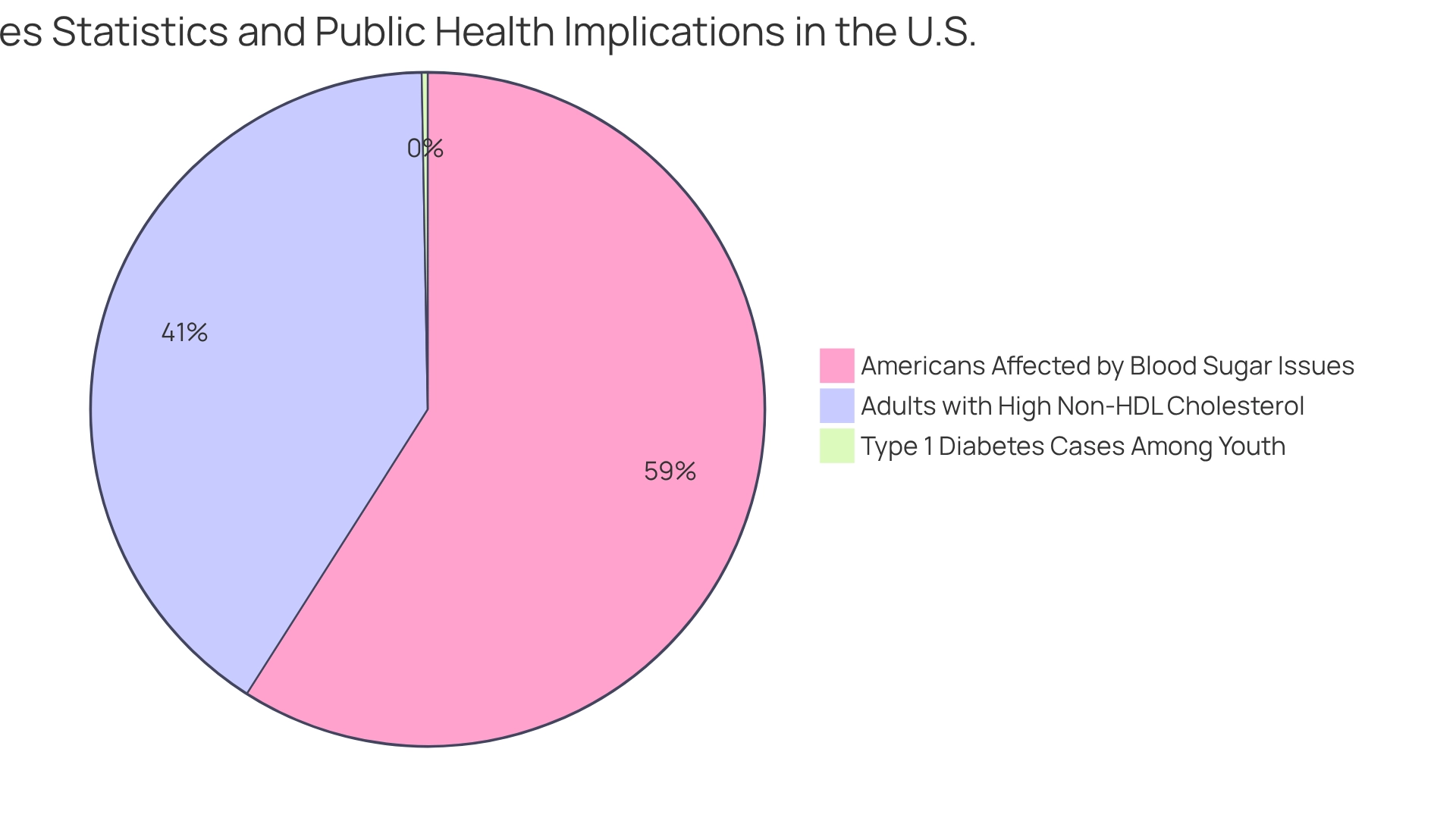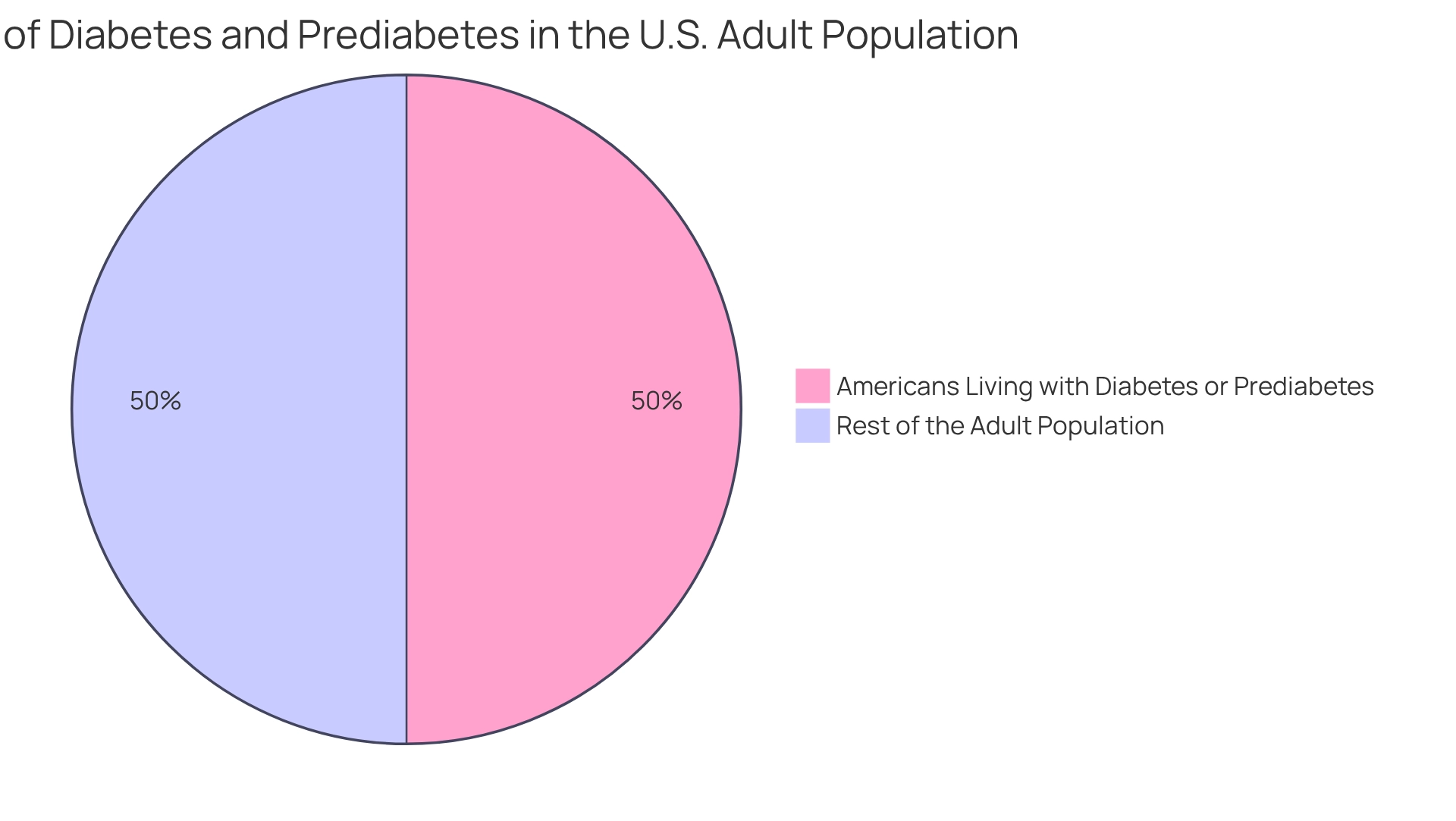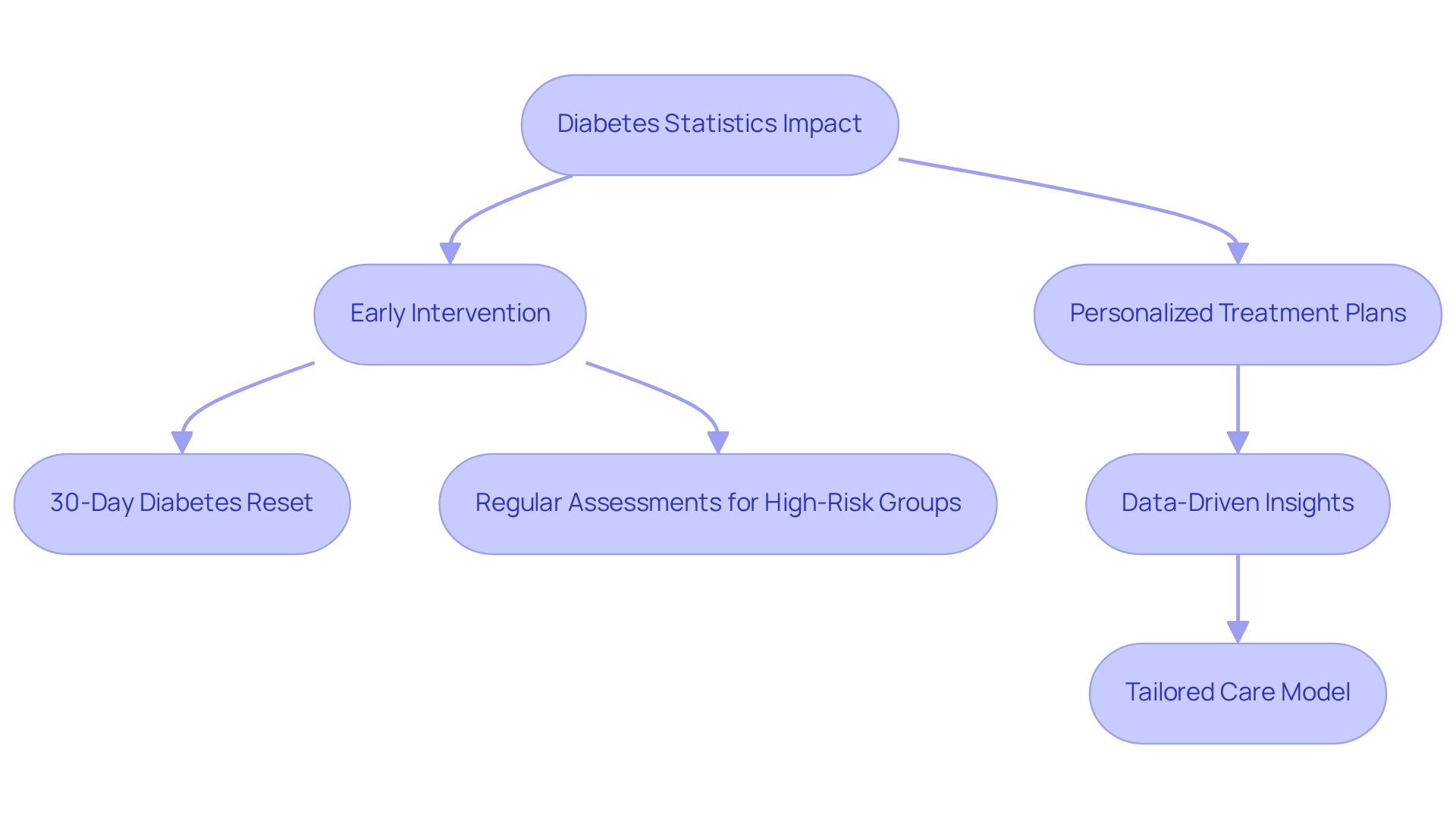Overview
The article highlights the vital role that American Diabetes Association statistics play in shaping public health strategies and interventions for diabetes management. It’s important to recognize the alarming prevalence of diabetes and its significant economic impact. This underscores the necessity for targeted prevention initiatives and early intervention strategies. These efforts are essential for improving health outcomes and managing this growing public health crisis. Many patients find that understanding these statistics can be a wake-up call, motivating them to take charge of their health. By focusing on prevention, we can foster a healthier future for everyone affected by diabetes.
Introduction
In the realm of public health, diabetes statistics act as a vital compass, guiding us in our efforts to address a growing epidemic that impacts millions. It’s important to recognize that approximately 38.4 million Americans are grappling with diabetes and its related complications. This reality underscores the urgent need for targeted interventions. These figures not only reveal the staggering prevalence of the disease but also highlight the economic toll it takes on our society.
Many patients find that understanding these statistics can empower them. By delving into their significance, health professionals can identify at-risk populations, tailor effective treatments, and implement preventive measures that encourage individuals to take charge of their health. As the landscape of diabetes continues to evolve, grasping these trends is crucial for shaping future healthcare initiatives. Together, we can foster a culture of proactive health management that supports everyone on their journey toward better health.
Explore the Importance of Diabetes Statistics in Public Health
The American Diabetes Association statistics are vital in public welfare, offering important insights into the disease’s prevalence, incidence, and economic consequences. According to American Diabetes Association statistics, as of 2025, around 38.4 million Americans, or 11.6% of the population, are affected by blood sugar issues. This statistic underscores the urgent need for effective public wellness strategies according to American Diabetes Association statistics.
It’s important to recognize that the American Diabetes Association statistics emphasize that 8.0% of U.S. adults with diagnosed conditions have a non-HDL cholesterol level of 190 mg/dL or higher, indicating a significant health risk that necessitates targeted interventions. Many patients find that analyzing these statistics enables health professionals to identify at-risk populations, tailor interventions, and allocate resources more effectively.
For example, the Diabetes Prevention Program outlines standards of care for Type 2 conditions, emphasizing that lifestyle changes, including diet and exercise, can prevent the onset of the illness. In San Marcos, adopting a balanced diet abundant in local produce, like avocados and berries, along with consistent outdoor exercise in the area’s parks and trails, can greatly improve health management.
Evidence indicates that weight loss and enhanced physical activity, especially by participating in community wellness programs, significantly lower the risk of developing Type 2 conditions. This emphasizes the significance of early intervention. Additionally, adopting preventive actions can result in lasting wellness advantages, highlighting the necessity for proactive approaches.
Furthermore, comprehending patterns in the prevalence of blood sugar issues, as highlighted by the American Diabetes Association statistics, assists in predicting future medical requirements and developing educational initiatives that encourage healthier living. Public wellness specialists believe that understanding these statistics enables individuals and communities to take proactive measures in management and prevention.
Significantly, although Type 1 is more common among young individuals, with 185,000 cases documented, Type 2 is increasing in this group. This renders extensive public wellness strategies ever more essential. As Type 2 sugar intolerance continues to rise, especially among young people, the necessity for comprehensive public health strategies based on these statistics becomes increasingly vital. This ensures that resources are directed where they are most essential to enhance health outcomes.
For customized advice and assistance suited to your distinct requirements, consider contacting Dr. Jason Shumard in San Marcos, CA. He is committed to supporting you in managing your health journey with compassion and skill.
Analyze Key American Diabetes Association Statistics and Trends
The American Diabetes Association statistics provide crucial insights that illuminate the challenges many face in managing diabetes. According to the American Diabetes Association statistics, around 136 million Americans are living with this metabolic disorder or prediabetes by 2025, meaning nearly half of the adult population is affected. This staggering figure underscores the urgent need for effective intervention strategies. The economic burden is equally concerning, with the American Diabetes Association statistics indicating that diabetes-related costs exceeded $412.9 billion in 2022. Projections from the American Diabetes Association statistics suggest that the prevalence of this condition may rise by 59.7% by 2025, highlighting the pressing necessity for proactive measures. It’s important to recognize that understanding these trends is vital for creating effective prevention initiatives. Many patients find that acknowledging the significance of lifestyle changes can greatly impact their well-being. For instance, engaging in regular physical activity can significantly lower the risk of complications; studies have shown that women who exercised at least four hours a week had a 40% reduced risk of developing heart disease compared to those who did not.
The ADA recommends maintaining a healthy weight and incorporating 150 to 300 minutes of moderate physical activity each week as preventive measures. This reinforces the idea that early support and lifestyle modifications are essential in addressing complications associated with type 2 conditions, such as cardiovascular disease and kidney problems. Dr. Jason Shumard, with nearly 20 years of experience in functional medicine, emphasizes that by equipping patients with actionable insights and practical tools, the Integrative Wellness Center nurtures an environment where individuals can reclaim their health and well-being.
This patient-focused approach ultimately leads to an enhanced quality of life and a reduced reliance on traditional medical treatments, empowering individuals to take charge of their condition management. Remember, you are not alone in this journey, and with the right support and resources, positive change is possible.
Discuss the Impact of Diabetes Statistics on Treatment and Prevention Strategies
The impact of blood sugar condition statistics on treatment and prevention strategies is profound. With over 98 million adults classified as prediabetic, the urgency for early intervention strategies has never been greater. Have you or someone you care about been feeling overwhelmed by this diagnosis? Programs like the 30-Day Diabetes Reset, developed by Dr. Jason Shumard, are designed to empower patients with essential knowledge and practical tools for effective condition management.
This transformative program focuses on stabilizing glucose levels and revitalizing energy, addressing the underlying causes of Type 2 diabetes through personalized functional medicine approaches. It’s important to recognize that this proactive approach is crucial, as early detection and screening are vital for preventing complications associated with diabetes.
Establishing regular assessments for high-risk groups, as suggested by guidelines, can greatly improve management results and decrease the chances of severe medical issues, as highlighted by the American Diabetes Association statistics. By utilizing data-driven insights, healthcare providers can tailor interventions to meet the unique needs of their patients. Many patients find that this tailored care model is crucial for enhancing health outcomes, as it enables focused strategies that tackle specific challenges encountered by individuals with this condition.
As the prevalence of type 2 blood sugar disorder continues to rise, the American Diabetes Association statistics project an increase from 5.9% in 2021 to 9.5% by 2050—accounting for more than 1.27 billion individuals—thus necessitating that the healthcare landscape adapts accordingly. The emphasis on early intervention and personalized treatment plans, such as those offered by Dr. Shumard, will be critical in managing this growing epidemic effectively.
As noted by Md. Jamal Hossain, undiagnosed diabetes presents a dual hazard, manifesting as both a financial burden and a source of complications for individuals, communities, and healthcare systems alike. Remember, you are not alone in this journey, and there are resources available to support you.
Conclusion
The alarming statistics surrounding diabetes highlight the urgent need for effective public health strategies and targeted interventions. With approximately 38.4 million Americans living with diabetes and nearly 136 million affected by diabetes or prediabetes, it is clear that the scale of this epidemic demands immediate action. It’s important to recognize that understanding these figures not only sheds light on the prevalence of the disease but also emphasizes the economic burden it places on society, with costs exceeding $412.9 billion in 2022.
Empowering individuals through knowledge of these statistics can lead to proactive health management and lifestyle changes that significantly reduce the risk of complications. Many patients find that programs designed to promote early intervention, such as the Diabetes Prevention Program, emphasize the importance of lifestyle modifications, including diet and exercise, which can prevent the onset of Type 2 diabetes. The role of healthcare professionals in tailoring treatment plans based on these insights is crucial, enabling personalized care that addresses the specific challenges faced by individuals.
As the landscape of diabetes continues to evolve, it is imperative to foster a culture of awareness and proactive health management. By prioritizing education and community wellness initiatives, society can work together to combat the diabetes epidemic effectively. The path forward lies in a collective commitment to understanding and leveraging diabetes statistics, ultimately paving the way for healthier futures for millions. Together, we can make a difference, supporting one another in this journey toward better health.
Frequently Asked Questions
What do the American Diabetes Association statistics reveal about the prevalence of diabetes in the U.S. as of 2025?
As of 2025, approximately 38.4 million Americans, or 11.6% of the population, are affected by blood sugar issues.
What percentage of U.S. adults with diagnosed diabetes have a non-HDL cholesterol level of 190 mg/dL or higher?
About 8.0% of U.S. adults with diagnosed conditions have a non-HDL cholesterol level of 190 mg/dL or higher, indicating a significant health risk.
How do the American Diabetes Association statistics assist health professionals?
These statistics help health professionals identify at-risk populations, tailor interventions, and allocate resources more effectively.
What lifestyle changes does the Diabetes Prevention Program recommend for preventing Type 2 diabetes?
The Diabetes Prevention Program emphasizes lifestyle changes, including diet and exercise, to prevent the onset of Type 2 diabetes.
What specific dietary and exercise recommendations are suggested for health management in San Marcos?
In San Marcos, adopting a balanced diet rich in local produce, such as avocados and berries, along with consistent outdoor exercise in parks and trails, is recommended for better health management.
What is the significance of early intervention in managing diabetes?
Early intervention, including weight loss and enhanced physical activity through community wellness programs, significantly lowers the risk of developing Type 2 diabetes.
How do the American Diabetes Association statistics aid in predicting future medical needs?
Understanding patterns in the prevalence of blood sugar issues helps in predicting future medical requirements and developing educational initiatives that promote healthier living.
What is the trend regarding Type 1 and Type 2 diabetes among young individuals?
While Type 1 diabetes is more common among young individuals, Type 2 diabetes is increasingly being diagnosed in this group, highlighting the need for extensive public wellness strategies.
Why are comprehensive public health strategies essential according to the article?
Comprehensive public health strategies are vital to ensure resources are directed effectively to improve health outcomes, especially as Type 2 diabetes continues to rise among young people.


